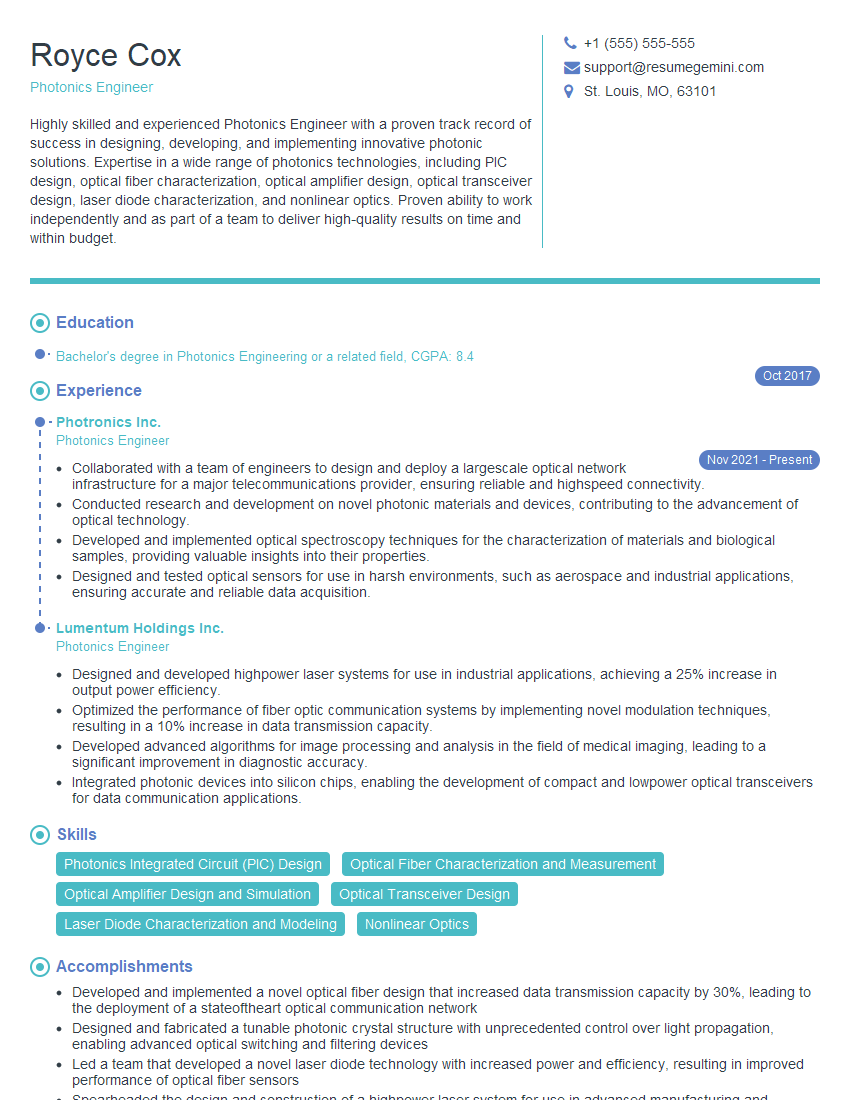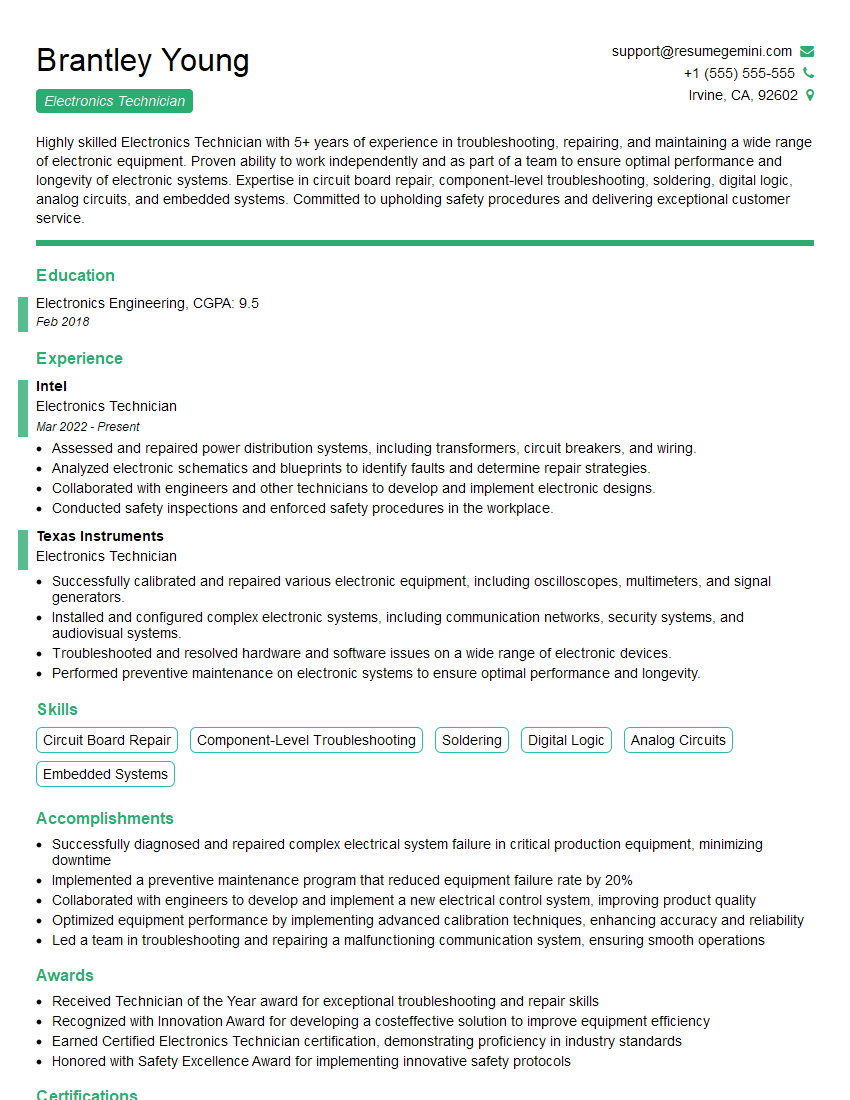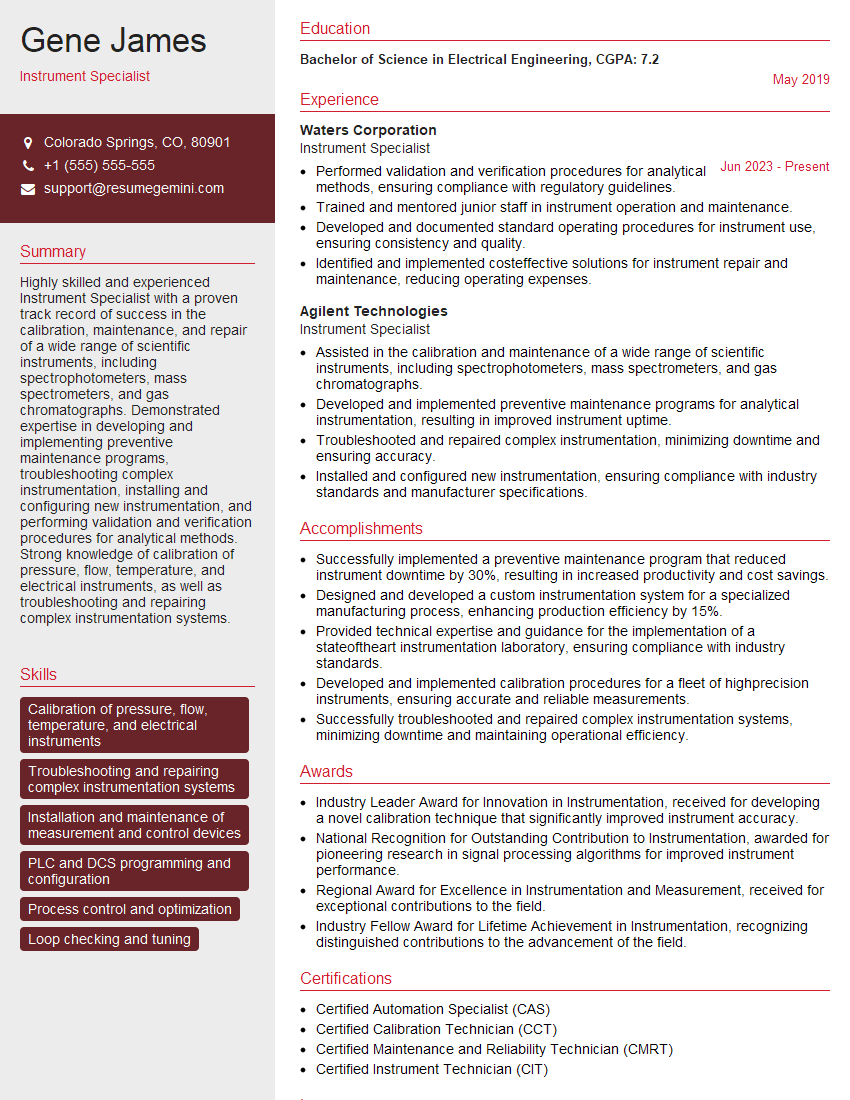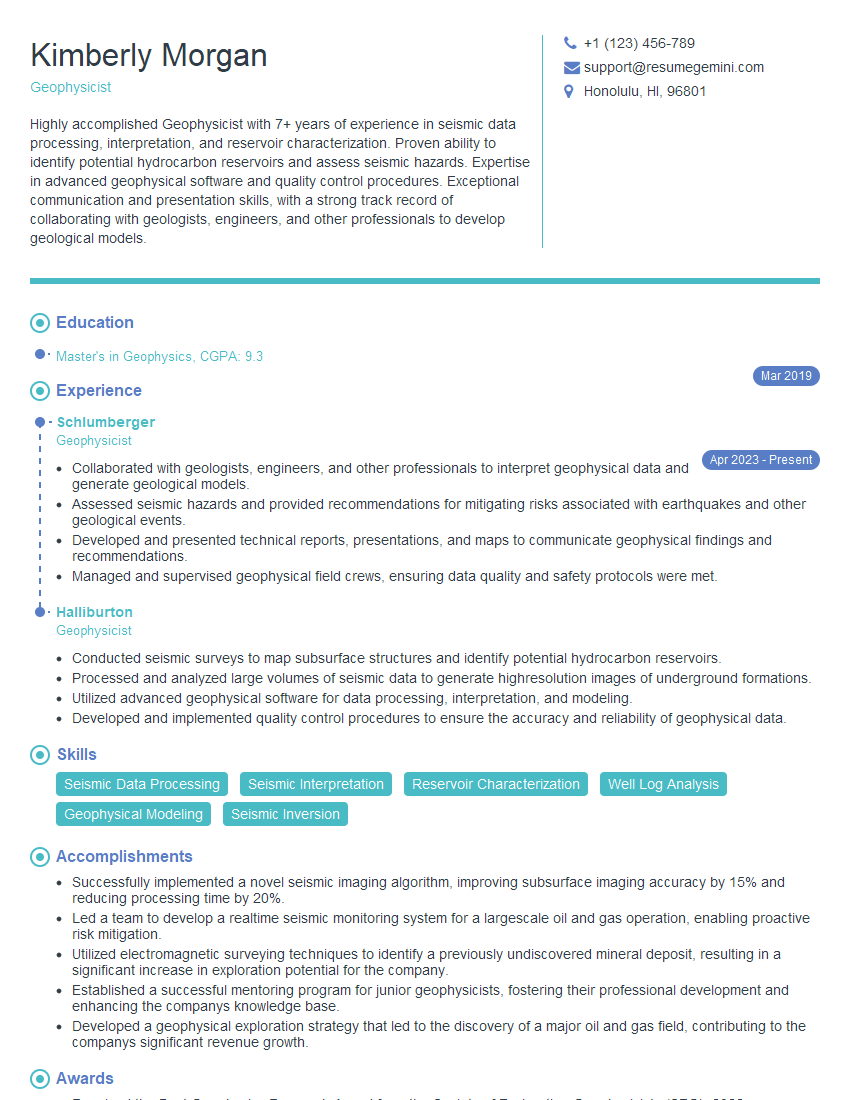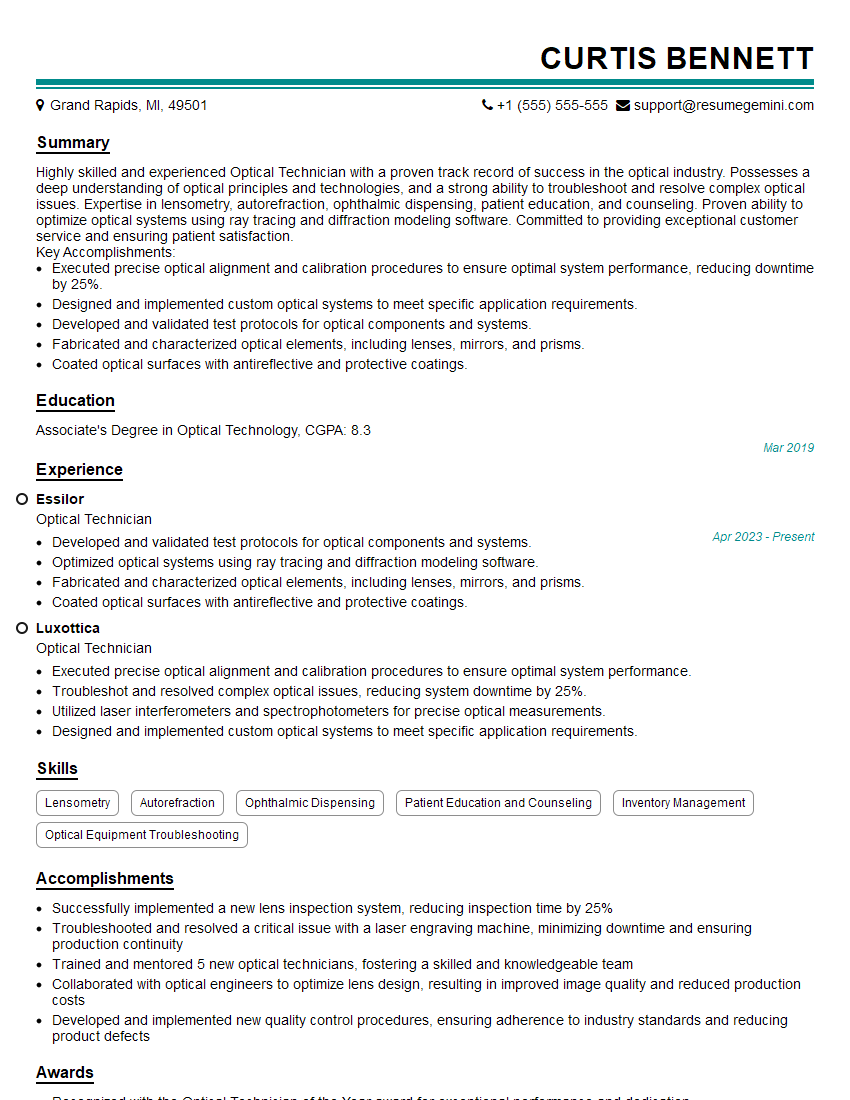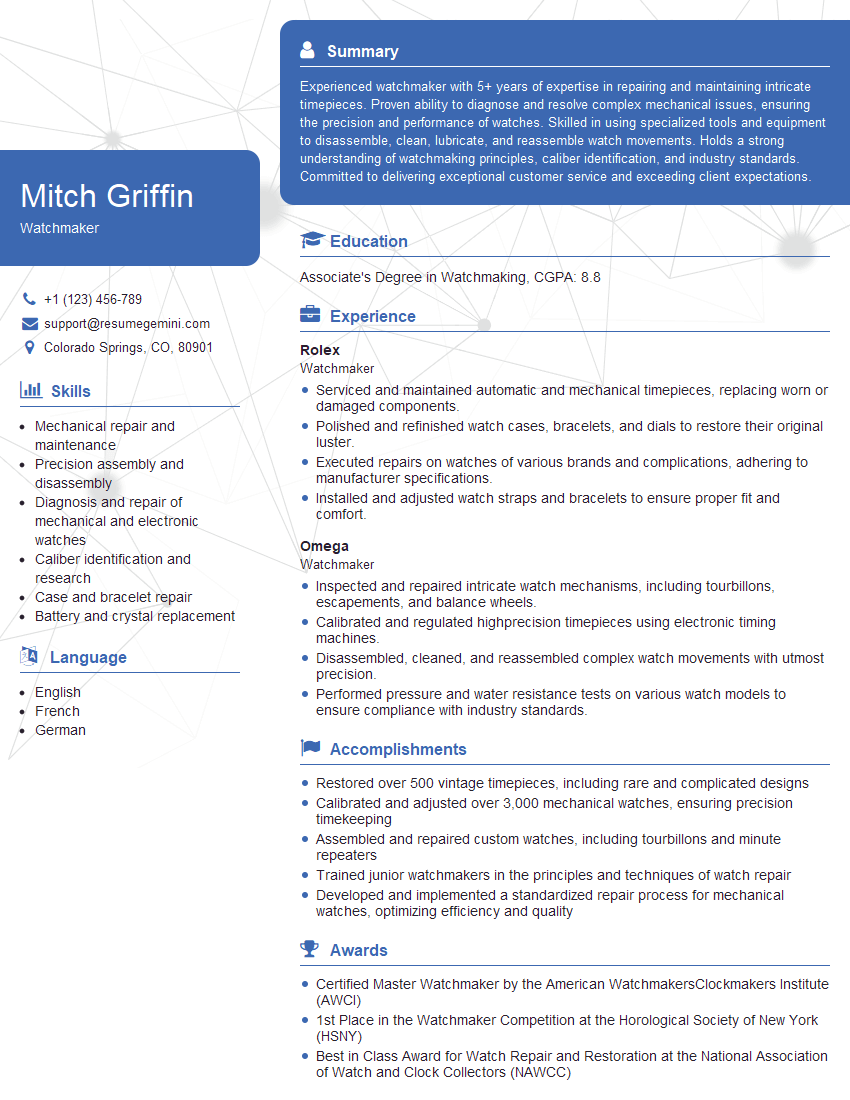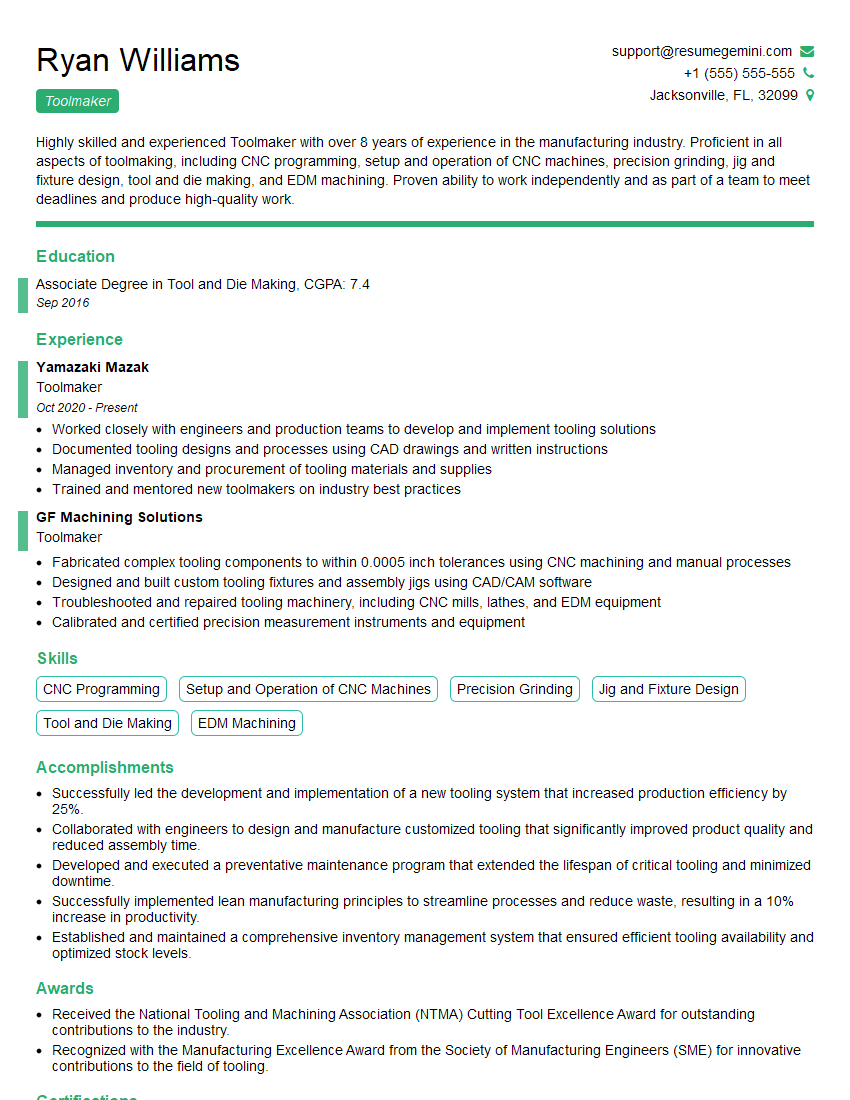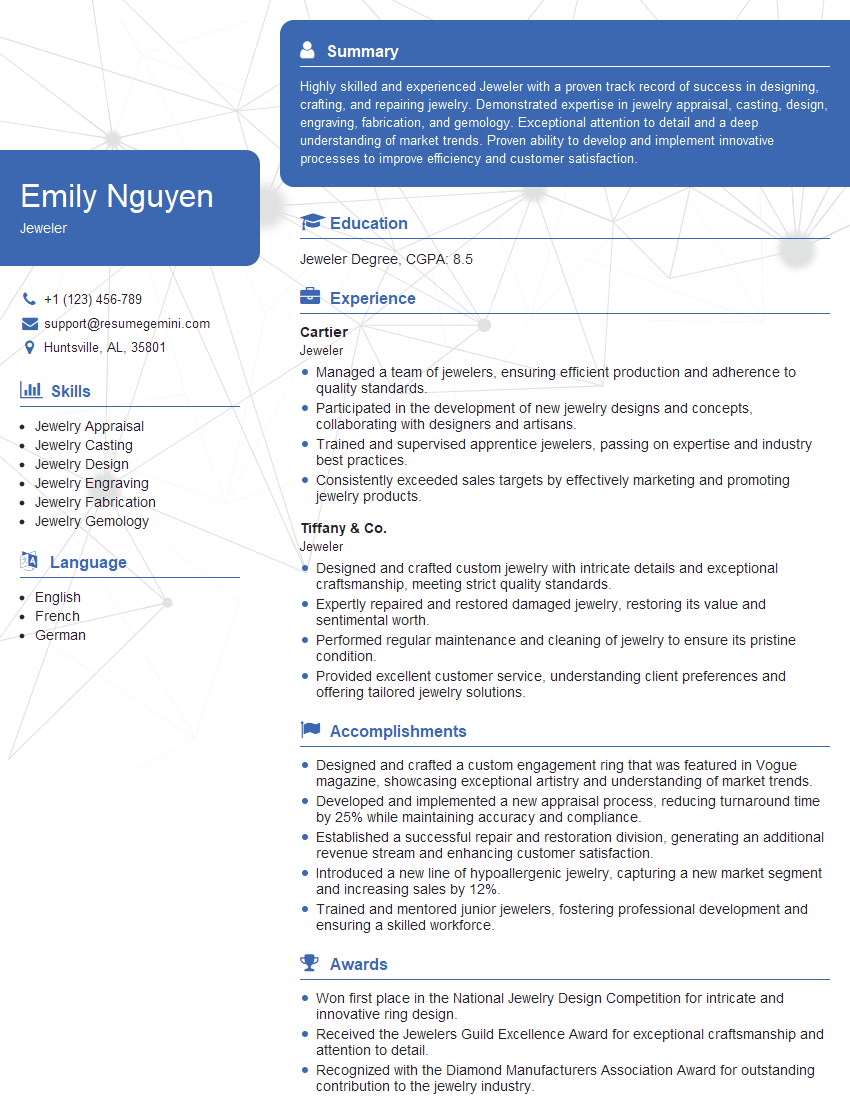Unlock your full potential by mastering the most common Use precision instruments interview questions. This blog offers a deep dive into the critical topics, ensuring you’re not only prepared to answer but to excel. With these insights, you’ll approach your interview with clarity and confidence.
Questions Asked in Use precision instruments Interview
Q 1. Describe your experience with different types of precision instruments.
My experience with precision instruments spans over a decade, encompassing a wide range of tools used in various scientific and engineering fields. I’ve worked extensively with instruments like micrometers, calipers, spectrometers, balances (analytical and top-loading), optical microscopes, and various types of sensors (temperature, pressure, displacement).
For example, in my previous role at Acme Corporation, I regularly used a high-precision micrometer to measure the diameter of manufactured components with tolerances in the micrometer range, ensuring adherence to strict quality standards. My experience also includes using spectrometers for material analysis in a research setting, requiring meticulous calibration and data interpretation. This diverse experience allows me to understand the unique characteristics and operational requirements of various precision instruments.
Q 2. Explain the process of calibrating a precision instrument.
Calibrating a precision instrument is a critical process ensuring accurate and reliable measurements. It involves comparing the instrument’s readings against a known standard of higher accuracy. The process generally involves these steps:
- Preparation: Establish a stable and controlled environment to minimize external influences on the measurement. This might include temperature and humidity control.
- Standard Selection: Select a traceable standard with a higher accuracy than the instrument being calibrated. These standards are typically certified by accredited laboratories.
- Measurement: Take multiple measurements using both the instrument under calibration and the standard, documenting each reading. Statistical methods are used to analyze these readings and minimize the effect of random errors.
- Comparison and Adjustment: Compare the readings. If there’s a significant deviation beyond the accepted tolerance, the instrument may require adjustment or repair. Many modern instruments allow for internal calibration adjustments.
- Documentation: Meticulously document the entire calibration process, including the date, time, environmental conditions, standard used, and any adjustments made. This documentation is crucial for traceability and quality control.
For instance, when calibrating a digital caliper, I’d use a calibrated gauge block of known dimensions and compare the caliper’s readings to the known dimensions of the gauge block at several points across its range. Any deviation outside the specified tolerance would lead to recalibration or instrument replacement.
Q 3. What are the common sources of error in precision measurements?
Precision measurements are susceptible to various error sources, broadly categorized into:
- Systematic Errors: These are consistent and repeatable errors caused by flaws in the instrument or measurement process. Examples include instrument misalignment, zero error in a balance, or environmental influences like temperature drift.
- Random Errors: These are unpredictable variations in measurements due to uncontrollable factors like vibrations, operator inconsistencies, or limitations in the instrument’s resolution.
- Parallax Error: This occurs when the reading is taken from an angle, causing an inaccurate measurement, particularly with analog instruments like rulers or vernier calipers.
- Environmental Errors: Temperature, humidity, and pressure fluctuations can influence the accuracy of many precision instruments.
For example, a systematic error might be observed if a micrometer’s jaws are not perfectly parallel, leading to consistently inaccurate measurements. Random errors could arise from slight variations in the way an operator applies pressure to the micrometer’s thimble.
Q 4. How do you ensure the accuracy and reliability of precision instruments?
Ensuring accuracy and reliability requires a multi-pronged approach:
- Regular Calibration: Consistent calibration against traceable standards is paramount. The frequency depends on the instrument, its use, and the required accuracy.
- Proper Handling and Maintenance: Instruments should be handled carefully, cleaned regularly, and stored properly to prevent damage and wear.
- Environmental Control: Maintaining a stable environment minimizes environmental errors. This might include temperature-controlled rooms or specialized enclosures for sensitive instruments.
- Operator Training: Proper training on the instrument’s operation and limitations is vital to minimize human error. This includes understanding calibration procedures and error sources.
- Preventative Maintenance: Following the manufacturer’s recommended maintenance schedules ensures the instrument is functioning optimally.
For example, regularly cleaning a spectrometer’s optical components is crucial for maintaining its accuracy. Similarly, ensuring the correct calibration weight is used during the calibration process of a balance is equally important.
Q 5. Describe your experience with specific precision instruments (e.g., micrometer, caliper, spectrometer).
I have extensive hands-on experience with several precision instruments:
- Micrometer: I’ve used micrometers to measure the thickness of thin films, the diameter of wires, and other small components with high precision, often to within a few micrometers.
- Caliper: Calipers have been essential for measuring various dimensions of objects, particularly in manufacturing and quality control settings. I’m proficient in using both digital and vernier calipers.
- Spectrometer: My experience with spectrometers includes analyzing the composition of materials by measuring their spectral signatures. This has involved both UV-Vis and FTIR spectroscopy, requiring careful sample preparation and data analysis.
In one project, I used a micrometer to accurately measure the thickness of a wafer during a semiconductor manufacturing process. The precision of the micrometer was crucial for ensuring the quality of the final product. The slightest error could impact the functionality and performance of the device.
Q 6. How do you troubleshoot malfunctions in precision instruments?
Troubleshooting malfunctions requires a systematic approach:
- Initial Assessment: Observe the instrument for any obvious signs of damage or malfunction. Note any error messages displayed.
- Check Calibration: Verify if the instrument has been recently calibrated. If not, perform a calibration. Often, slight miscalibration is mistaken for malfunction.
- Environmental Factors: Assess the environmental conditions (temperature, humidity, power supply). External factors can significantly impact instrument function.
- Consult Documentation: Refer to the instrument’s manual for troubleshooting guidance and potential solutions.
- Seek Expert Assistance: If the problem persists, seek assistance from qualified technicians or the manufacturer.
For example, if a spectrometer displays an error message indicating a low signal-to-noise ratio, I would first check the alignment of the optical components, the cleanliness of the optical surfaces, and the sample preparation. If these do not solve the issue, I would then consult the manufacturer’s documentation for further troubleshooting steps.
Q 7. What safety precautions do you take when using precision instruments?
Safety is paramount when using precision instruments. My safety practices include:
- Proper Training: I always ensure I’m adequately trained on the specific instrument before use.
- Eye Protection: I wear appropriate eye protection, especially when working with lasers or other potentially hazardous light sources (e.g., spectrometers).
- Appropriate Clothing: I wear appropriate clothing to minimize the risk of entanglement or contamination of the instrument.
- Careful Handling: I handle instruments carefully, avoiding dropping or bumping them.
- Following Manufacturer Guidelines: I strictly adhere to the manufacturer’s instructions and safety guidelines provided in the instrument’s manual.
- Proper Disposal: I dispose of any hazardous materials (e.g., solvents) according to proper safety procedures.
For example, when using a high-powered laser in a spectrometer, I always ensure the laser safety interlocks are functioning correctly and that the laboratory is properly shielded from stray laser beams.
Q 8. Explain the importance of maintaining precision instruments.
Maintaining precision instruments is paramount for ensuring accurate and reliable measurements. Neglecting proper maintenance leads to inaccurate data, potentially causing significant issues in various fields, from manufacturing and research to healthcare and environmental monitoring. Think of it like this: a poorly maintained scale will give you an incorrect weight, impacting everything from recipe measurements to critical medical dosages.
- Calibration: Regular calibration against traceable standards ensures the instrument’s readings align with known values. This is crucial for maintaining accuracy over time.
- Cleaning: Dust, debris, and other contaminants can obstruct delicate components and affect readings. A clean instrument ensures optimal performance. The cleaning procedure varies depending on the instrument; some may require specialized cleaning solutions, while others only need gentle wiping.
- Proper Storage: Instruments should be stored in controlled environments to protect them from damage, corrosion, and temperature fluctuations that can affect their accuracy. This often involves climate-controlled storage, using protective cases, and avoiding exposure to extreme conditions.
- Preventative Maintenance: This involves routine checks, lubrication (where applicable), and minor adjustments as per the manufacturer’s instructions. Early detection and prevention of problems significantly extend the lifespan and accuracy of the instruments.
Q 9. How do you interpret data obtained from precision instruments?
Interpreting data from precision instruments involves more than just reading the displayed value. It requires understanding the instrument’s limitations, potential sources of error, and applying statistical methods for data analysis.
- Understanding Instrument Specifications: Before analyzing data, carefully review the instrument’s specifications, including accuracy, precision, resolution, and any known limitations. This is crucial for assessing the reliability of the measurements.
- Identifying Outliers and Errors: Examine the data for outliers or inconsistencies that might indicate measurement errors. These errors can arise from various sources, including operator error, instrument malfunction, or environmental factors. Statistical methods like the Grubbs’ test can help identify outliers.
- Applying Statistical Analysis: Use appropriate statistical methods (e.g., mean, standard deviation, confidence intervals) to analyze and summarize the data. This provides a quantitative representation of the measurements and their uncertainty.
- Considering Uncertainty: Always express the measurements with their associated uncertainties. This reflects the limitations of the measurement process and provides a more realistic representation of the results.
For example, if I’m measuring the diameter of a component using a micrometer, I wouldn’t just report the single reading. Instead, I’d take multiple readings, calculate the average, standard deviation, and report the result with the associated uncertainty, perhaps as 10.00 ± 0.02 mm.
Q 10. Describe your experience with statistical process control (SPC) in relation to precision instruments.
Statistical Process Control (SPC) is crucial for monitoring the performance of precision instruments and the processes they are used in. It helps detect variations and trends, ensuring consistent and accurate measurements over time. I’ve extensively used control charts (e.g., X-bar and R charts, Shewhart charts) to monitor the performance of various instruments. For instance, while working on a semiconductor fabrication process, we used SPC to monitor the thickness of thin films measured using an optical profilometer. By tracking the measurements over time, we could identify drifts in the instrument’s performance or changes in the process itself, allowing us to proactively address any issues and maintain high quality.
Through SPC, we were able to detect a subtle drift in the profilometer’s readings that went undetected initially. By analyzing the control charts, we recognized a pattern indicative of a gradual change. Further investigation revealed a slight misalignment within the instrument. Addressing this issue prevented the creation of faulty semiconductor components that would have been far more costly to rectify later.
Q 11. What are the different types of precision measurement uncertainties?
Precision measurement uncertainties stem from various sources and can be classified into several types:
- Random Uncertainties: These are unpredictable variations that occur due to numerous small, uncontrollable factors. They are typically characterized by a normal distribution and can be quantified using statistical methods like standard deviation.
- Systematic Uncertainties: These are consistent errors that affect all measurements in a particular way. They can stem from instrument calibration errors, environmental influences, or a consistent bias in the measurement technique. Careful calibration and environmental control help minimize systematic uncertainties.
- Resolution Uncertainty: This represents the limitation of the instrument’s ability to display finer gradations in the measurement. For example, an instrument with a resolution of 0.1 mm cannot provide measurements more precise than that.
- Uncertainty due to Operator Error: This arises from variations in the operator’s technique. Proper training and standardized procedures help minimize this type of uncertainty.
Q 12. How do you handle discrepancies in measurements obtained from different instruments?
Discrepancies in measurements obtained from different instruments require careful investigation. It’s not enough to simply choose one measurement; a systematic approach is needed.
- Check Instrument Calibration: Verify that all instruments used are properly calibrated and traceable to national or international standards. Calibration errors are a common source of discrepancies.
- Evaluate Measurement Techniques: Ensure that consistent measurement techniques were used by all operators. Variations in techniques can introduce errors.
- Analyze Environmental Factors: Consider potential environmental factors (temperature, humidity, vibration) that could have differentially affected the instruments. Environmental control is often critical.
- Investigate Instrument Specifications: Review the specifications of each instrument, including accuracy, precision, and resolution, to determine if the observed discrepancies are within their expected range. Instruments may have different tolerances.
- Statistical Analysis: Use statistical methods to determine if the discrepancies are statistically significant or simply due to random variations. Statistical tests (e.g., t-test, ANOVA) can be applied to check for significant differences between multiple instruments.
- Identify and Address the Root Cause: Once the source of the discrepancy is identified, take steps to correct it. This might involve recalibrating instruments, improving measurement techniques, or replacing faulty equipment.
Q 13. Explain your understanding of instrument resolution and accuracy.
Instrument resolution and accuracy are distinct but related concepts that are crucial for understanding the capabilities of a precision instrument.
- Resolution: This refers to the smallest increment that the instrument can display or measure. It determines the level of detail that the instrument can provide. A higher resolution means finer gradations are possible, leading to greater precision in measurements. For example, a micrometer with a resolution of 0.01 mm is more precise than one with a resolution of 0.1 mm.
- Accuracy: This refers to how closely the instrument’s readings match the true value of the measured quantity. Accuracy is influenced by various factors, including calibration, systematic errors, and the instrument’s inherent limitations. A highly accurate instrument produces readings that are very close to the actual value.
It’s important to note that high resolution doesn’t automatically imply high accuracy. An instrument can have high resolution but still be inaccurate if it is not properly calibrated or has systematic errors. Conversely, a low-resolution instrument might be quite accurate if its calibration is excellent and its systematic errors are minimal.
Q 14. Describe your experience with different measurement units (e.g., micrometers, nanometers).
I have extensive experience working with various measurement units, ranging from millimeters and micrometers to nanometers and even angstroms, depending on the application and the precision required. My experience includes:
- Micrometers (µm): Used extensively in mechanical engineering, manufacturing, and material science, for measuring dimensions of components and materials with high precision.
- Nanometers (nm): Commonly used in nanotechnology, semiconductor fabrication, and optical metrology, requiring specialized instruments such as atomic force microscopes or optical interferometers for accurate measurements.
- Angstroms (Å): While less common now due to the prevalence of nanometers, angstroms are still used in some contexts, particularly in describing atomic distances and crystal structures.
The choice of measurement unit depends entirely on the scale of the measurement. For example, when working with thin films in semiconductor manufacturing, measurements in nanometers are necessary due to the extremely small thickness of these layers. In contrast, measurements of larger components might require only millimeters or centimeters. Understanding the appropriate units and the limitations of various instruments is critical for selecting the right tool for the job.
Q 15. How do you select the appropriate precision instrument for a given task?
Selecting the right precision instrument involves a careful consideration of several factors. It’s like choosing the right tool for a job – a hammer won’t help you tighten a screw! First, you must clearly define the measurement task: what parameter needs to be measured (length, mass, temperature, etc.), what is the required accuracy and precision, and what is the range of values expected? Then, you consider the instrument’s specifications: its resolution (smallest measurable increment), accuracy (closeness to the true value), repeatability (consistency of measurements), and linearity (consistent response across the measurement range). Environmental factors also play a role; for example, a highly sensitive balance needs a stable, vibration-free environment. Finally, practical considerations like cost, ease of use, and availability are weighed. For instance, measuring the diameter of a hair might necessitate a high-resolution optical micrometer, while measuring the weight of a small gemstone might require an analytical balance with a high sensitivity.
A systematic approach includes:
- Defining the measurement requirements: Accuracy, precision, range, and sample characteristics.
- Researching available instruments: Consulting specifications and reviews from manufacturers.
- Comparing specifications: Identifying the instrument that best meets the requirements within budget constraints.
- Considering environmental factors: Temperature, humidity, vibrations, and electromagnetic interference.
Career Expert Tips:
- Ace those interviews! Prepare effectively by reviewing the Top 50 Most Common Interview Questions on ResumeGemini.
- Navigate your job search with confidence! Explore a wide range of Career Tips on ResumeGemini. Learn about common challenges and recommendations to overcome them.
- Craft the perfect resume! Master the Art of Resume Writing with ResumeGemini’s guide. Showcase your unique qualifications and achievements effectively.
- Don’t miss out on holiday savings! Build your dream resume with ResumeGemini’s ATS optimized templates.
Q 16. Explain the concept of traceability in precision measurements.
Traceability in precision measurements ensures that the results of a measurement can be linked back to internationally recognized standards. Think of it as a chain of custody for your measurements, ensuring their validity and comparability. It’s achieved through a documented series of calibrations, where the instrument is compared to a known standard, which in turn is traceable to a higher-level standard, and ultimately, to a national or international standard (like those maintained by NIST or BIPM). Without traceability, your measurements are essentially meaningless as there is no reliable way to verify their accuracy. This is crucial in many industries, such as pharmaceuticals, aerospace, and manufacturing, where precise and reliable measurements are essential for quality control and safety.
For example, if you are using a digital caliper to measure the dimensions of a part for an aircraft engine, you need to ensure that the caliper’s calibration is traceable to a national standard. This means that the caliper has been calibrated against a traceable standard, and a certificate of calibration providing this documentation should be readily available.
Q 17. Describe your experience with data logging and analysis from precision instruments.
My experience with data logging and analysis from precision instruments is extensive. I’ve worked with various instruments, including spectrometers, chromatographs, and multimeters, using both dedicated instrument software and general-purpose data acquisition software like LabVIEW. The process typically involves connecting the instrument to a computer via various interfaces (USB, GPIB, Ethernet), configuring the instrument settings for data acquisition, selecting appropriate sampling rates and durations, and then exporting the data into a usable format (e.g., CSV, text file). Data analysis often involves using statistical software (like R or MATLAB) to identify trends, calculate averages, perform regressions, and generate visualizations to support interpretations and reporting.
For instance, during a recent project analyzing the composition of a polymer, I used a gas chromatograph coupled with a mass spectrometer. The instrument’s software automated data acquisition, generating raw data files. I then used custom scripts in MATLAB to process the data, performing peak integration, identifying components, and calculating their concentrations. The resulting data allowed us to determine the purity and chemical composition of the polymer sample with high confidence.
Q 18. How do you document the calibration and maintenance of precision instruments?
Calibration and maintenance of precision instruments are meticulously documented to maintain their accuracy and reliability. This documentation typically includes a detailed record of each calibration event, including the date, the calibration procedure followed, the standard used for comparison, the results obtained, and any adjustments made to the instrument. A calibration certificate or report is generated, usually bearing the signature of a qualified technician and the details of the testing facility. Maintenance logs record routine checks, cleaning, and any repairs or replacements carried out, along with the date, personnel involved and a description of the work. This detailed history allows us to track the instrument’s performance over time and ensures that any potential issues are addressed promptly, preserving data quality and regulatory compliance.
All documentation, both calibration certificates and maintenance logs, is stored securely, often in a digital database or a designated physical file system, ensuring easy access and archival for future reference. This detailed record-keeping is essential not only for quality assurance but also for regulatory compliance in many sectors.
Q 19. What is your experience with using specific software for data acquisition and analysis from precision instruments?
I have extensive experience with various software packages for data acquisition and analysis from precision instruments. My proficiency includes LabVIEW (National Instruments), which is particularly useful for custom data acquisition systems and complex automated measurements. I’m also familiar with instrument-specific software provided by manufacturers like Agilent (for spectroscopy), Thermo Fisher Scientific (for chromatography), and others. In addition, I utilize general-purpose data analysis software like MATLAB and R for statistical analysis, data visualization, and advanced modeling of the acquired data.
For example, in one project, we used LabVIEW to control a custom-built robotic system equipped with high-precision sensors. LabVIEW’s graphical programming environment facilitated seamless data acquisition from multiple sensors simultaneously, allowing us to automate the measurement process and perform real-time analysis. Subsequently, the data was exported to MATLAB for detailed statistical analysis and model building.
Q 20. How do you ensure the cleanliness and proper handling of precision instruments?
Cleanliness and proper handling are paramount in maintaining the accuracy and longevity of precision instruments. This involves following strict procedures to prevent contamination or damage. Before handling any instrument, hands should be cleaned and appropriate personal protective equipment (PPE) may be required, depending on the specific instrument and the nature of the measurement. The instrument’s surfaces should be cleaned regularly using appropriate cleaning solutions and lint-free materials, preventing the buildup of dust, debris, or corrosive materials. Instruments should be stored in their protective cases or designated storage areas when not in use, shielded from environmental factors like excessive temperature, humidity, or vibration. Proper handling techniques should be observed to prevent accidental drops or impacts. Following the manufacturer’s instructions is critical.
For example, when using a microscope, it is crucial to clean the lenses regularly with lens paper to avoid scratches and maintain image clarity. Similarly, an analytical balance requires a clean environment and careful handling to prevent errors caused by dust or vibrations.
Q 21. Describe your experience with different types of microscope and their applications.
My experience encompasses various types of microscopes and their applications. I am proficient in using optical microscopes (brightfield, darkfield, phase contrast, fluorescence), electron microscopes (SEM, TEM), and confocal microscopes. Optical microscopes are commonly used for visualizing biological samples and materials with resolutions down to approximately 200 nm. The choice of optical microscopy technique depends on the sample’s properties and the desired information. For example, phase-contrast microscopy is ideal for observing transparent biological samples without staining, while fluorescence microscopy is essential for imaging specific molecules labeled with fluorescent dyes. Electron microscopes offer significantly higher resolution, reaching the nanometer scale, allowing for detailed imaging of surfaces (SEM) and internal structures (TEM) of various materials. Confocal microscopy is valuable for obtaining high-resolution 3D images of thick samples by eliminating out-of-focus light.
In a recent project, I used scanning electron microscopy (SEM) to analyze the surface morphology of a nanostructured material. The high resolution of the SEM allowed us to visualize the fine details of the nanostructures, providing crucial insights into the material’s properties and performance. In another project, we employed fluorescence microscopy to track the movement of proteins inside living cells.
Q 22. How would you identify and correct systematic errors in a measurement process?
Systematic errors, unlike random errors, are consistent and repeatable biases in measurements. They aren’t due to chance but stem from flaws in the measurement process itself. Identifying and correcting them requires a methodical approach.
Identify Potential Sources: Begin by carefully examining every step of your measurement process. Consider instrument calibration, environmental factors (temperature, humidity, pressure), operator bias (e.g., consistently misreading a scale), and the instrument’s inherent limitations. Create a checklist to ensure thoroughness.
Calibration and Verification: Regular calibration against traceable standards is crucial. This verifies the accuracy of your instruments. If an instrument is consistently off by a known amount, you can apply a correction factor to future readings. For example, if a micrometer consistently reads 0.002mm too low, you simply add 0.002mm to all measurements.
Control Experiments: Design experiments to isolate the source of error. For instance, if suspecting temperature influences, measure the same quantity under varying controlled temperatures and observe the trend. Similarly, multiple operators measuring the same sample can highlight operator-related bias.
Statistical Analysis: Analyze measurement data using statistical methods to identify trends and patterns. Look for consistent deviations from expected values. Techniques like regression analysis can help determine the relationship between potential error sources and measurement results, enabling correction factor derivation.
Corrective Actions: Based on your analysis, implement corrective actions. This might involve recalibrating instruments, adjusting environmental controls, improving operator training, or even replacing faulty equipment. Document all changes and repeat measurements to verify the effectiveness of your corrections.
Example: In a laboratory setting, consistently high readings from a spectrophotometer might indicate a drift in the baseline setting. Recalibrating the instrument using standard solutions is the necessary corrective action.
Q 23. Explain your understanding of linearity and repeatability in precision measurements.
Linearity refers to the instrument’s ability to produce a linear output that is proportional to the input across its entire operating range. In simpler terms, if you double the input, you should ideally double the output. Deviations from linearity introduce systematic errors. A graph of output versus input should ideally be a straight line. Any significant curvature indicates nonlinearity.
Repeatability, also known as precision, refers to how close successive measurements of the same quantity are to each other under the same conditions. High repeatability means the instrument produces consistent results when measuring the same thing multiple times. Repeatability is often expressed as standard deviation or variance of repeated measurements. Low repeatability points to random errors affecting the measurement.
Practical Application: Imagine a digital scale used for weighing precious metals. Linearity ensures that the scale accurately reflects the weight across its entire range (e.g., from 1 gram to 100 grams), while repeatability means that repeatedly weighing the same 50-gram weight will yield very similar results (e.g., within ±0.01 grams).
Q 24. Describe your experience with using and maintaining optical instruments.
My experience with optical instruments spans several years and includes microscopes (optical and confocal), spectrometers (UV-Vis, NIR), and interferometers. I’m proficient in their operation, including sample preparation and data acquisition, as well as maintenance procedures.
Microscopes: I’ve used optical microscopes for material characterization, identifying surface features, and analyzing microstructures. With confocal microscopes, I’ve performed 3D imaging and fluorescence microscopy. Maintenance involved regular cleaning of lenses using appropriate solvents and procedures, ensuring proper illumination, and careful handling to prevent damage.
Spectrometers: I’ve used UV-Vis and NIR spectrometers for quantitative and qualitative analysis of various materials, including polymers and biological samples. Routine maintenance involved regular wavelength calibration using certified standards and ensuring the cleanliness of optical components, like cuvettes and fibers.
Interferometers: My work with interferometers involved surface profile measurements and optical component testing. Maintenance here focused on environmental control (vibration isolation, temperature stability) to ensure accurate and stable measurements. Proper alignment and cleaning of optical components are critical.
I understand the importance of following manufacturers’ instructions meticulously for both operation and maintenance. Neglecting proper maintenance practices can lead to degraded performance, inaccurate results, and even damage to the instrument.
Q 25. How do environmental factors (temperature, humidity) affect precision measurements?
Environmental factors like temperature and humidity significantly impact precision measurements, especially with optical and mechanical instruments. These factors can cause:
Thermal Expansion/Contraction: Changes in temperature affect the dimensions of instruments and samples. This can lead to errors in length, volume, and other measurements. For example, a metal ruler will expand slightly with increasing temperature, leading to inaccurate length measurements.
Changes in Refractive Index: Temperature and humidity variations alter the refractive index of air, impacting the accuracy of optical measurements, especially in interferometry or spectroscopy. This can lead to shifts in wavelengths and distorted images.
Instrument Drift: Electronic components in precision instruments can be sensitive to temperature changes, resulting in signal drift or instability. This can be particularly problematic in sensitive measurements such as those involving thermocouples or resistance temperature detectors (RTDs).
Moisture Effects: Humidity can affect the stability of certain materials, causing dimensional changes or corrosion. This is particularly important for precision mechanical components.
Mitigation Strategies: Temperature and humidity control is essential. This might involve using climate-controlled environments, temperature-compensated sensors, or incorporating corrections based on environmental readings. For example, many digital calipers have temperature compensation features.
Q 26. How do you ensure the integrity of calibration standards?
Maintaining the integrity of calibration standards is paramount for ensuring accurate measurements. This involves careful handling, storage, and regular verification of the standards themselves.
Proper Handling: Calibration standards should be handled with care to prevent damage or contamination. This includes using appropriate gloves, clean tools, and avoiding unnecessary contact.
Storage Conditions: Standards often have specific storage requirements to maintain their accuracy. This might involve storing them in desiccators to control humidity, temperature-controlled environments, or specialized containers to prevent damage. Regular inspection for any signs of damage is crucial.
Regular Verification/Recalibration: Calibration standards aren’t permanent; their values can drift over time. They need to be periodically verified or recalibrated against higher-order standards traceable to national or international standards organizations (e.g., NIST). The frequency of this verification depends on the standard and its usage.
Chain of Custody: Maintain a detailed record of the standard’s history, including its original calibration certificate, any subsequent verifications, and any handling or storage information. This demonstrates traceability and ensures the validity of the calibration.
Example: A precision weight used for calibrating a balance needs to be stored in a desiccator to protect it from moisture. Its traceability to a national standard needs to be documented, and periodic verification checks against a higher-order standard must be conducted.
Q 27. What are the limitations of the precision instruments you have used?
Every precision instrument has its limitations. Some common ones include:
Resolution: The smallest increment that the instrument can measure. For example, a ruler with millimeter markings has a lower resolution than a micrometer with micrometer markings. Resolution limits the precision of the measurement.
Accuracy: The difference between the measured value and the true value. No instrument is perfectly accurate; there’s always some degree of error. Accuracy is often specified by the manufacturer as a tolerance or uncertainty.
Range: The measurable range of the instrument. An instrument may have high precision within its operating range but be unusable outside of it. Attempting measurements outside the range can lead to inaccurate or unreliable results.
Sensitivity: The instrument’s ability to detect small changes in the measured quantity. A less sensitive instrument may miss small variations, whereas a highly sensitive instrument may be susceptible to noise.
Environmental Sensitivity: As discussed previously, temperature, humidity, and other environmental factors can affect instrument performance. High environmental sensitivity limits the instrument’s accuracy and reliability in uncontrolled environments.
Understanding these limitations is essential for appropriate instrument selection and data interpretation. You can’t expect a resolution of 0.001 mm from an instrument designed for millimeter-level measurements.
Q 28. Describe a time you had to troubleshoot a complex problem related to a precision instrument.
During a research project involving thin-film deposition, our atomic force microscope (AFM) started producing inconsistent and unreliable images. The images were blurry, and the measured surface roughness values varied significantly from scan to scan. Troubleshooting this involved a systematic approach.
Initial Checks: We started with basic checks, ensuring the cantilever was properly installed and that the tip was not damaged. We also verified the correct settings for scan parameters, such as scan rate and setpoint.
Environmental Factors: We carefully considered environmental factors. We observed that the AFM was close to a vibrating piece of equipment. We moved it to a more stable location, significantly reducing vibrations.
Calibration: Despite the relocation, the problem persisted. We calibrated the AFM using a standard sample with a known surface roughness. This revealed a slight calibration drift, which we corrected.
Software and Firmware: We suspected the problem could also lie with the AFM software or firmware. We checked for software updates and reinstalled the software, which resolved the issue. Further investigation revealed a minor bug that caused inconsistent data acquisition.
Cleaning: Finally, we performed a thorough cleaning of the AFM components, paying particular attention to the optical system, to rule out any dust accumulation.
This systematic troubleshooting approach, starting with simple checks and gradually progressing to more advanced steps, allowed us to identify the issue efficiently and obtain reliable AFM data.
Key Topics to Learn for Use Precision Instruments Interview
- Instrument Calibration and Maintenance: Understanding calibration procedures, troubleshooting common issues, and performing preventative maintenance on various precision instruments.
- Measurement Techniques and Error Analysis: Mastering different measurement techniques, identifying potential sources of error, and applying appropriate statistical methods for data analysis.
- Data Acquisition and Interpretation: Proficiency in using software and hardware for data acquisition, understanding data representation, and interpreting results accurately.
- Safety Procedures and Regulations: Knowledge of relevant safety protocols, handling hazardous materials, and adhering to industry regulations when using precision instruments.
- Specific Instrument Knowledge: Depending on the role, in-depth understanding of specific instruments like microscopes, spectrometers, balances, or other relevant equipment.
- Problem-solving and Troubleshooting: Developing a systematic approach to identifying and resolving issues related to instrument malfunction, inaccurate readings, or experimental failures.
- Documentation and Reporting: Maintaining detailed records of experiments, calibrations, and maintenance procedures; effectively communicating results through clear and concise reports.
Next Steps
Mastering the use of precision instruments is crucial for career advancement in numerous scientific and technical fields. A strong understanding of these techniques will significantly enhance your employability and open doors to exciting opportunities. To maximize your job prospects, it’s essential to create an ATS-friendly resume that highlights your skills and experience effectively. We strongly recommend using ResumeGemini, a trusted resource, to build a professional and impactful resume. ResumeGemini provides examples of resumes tailored to roles involving the use of precision instruments, helping you showcase your qualifications in the best possible light.
Explore more articles
Users Rating of Our Blogs
Share Your Experience
We value your feedback! Please rate our content and share your thoughts (optional).
What Readers Say About Our Blog
Hi, I’m Jay, we have a few potential clients that are interested in your services, thought you might be a good fit. I’d love to talk about the details, when do you have time to talk?
Best,
Jay
Founder | CEO







